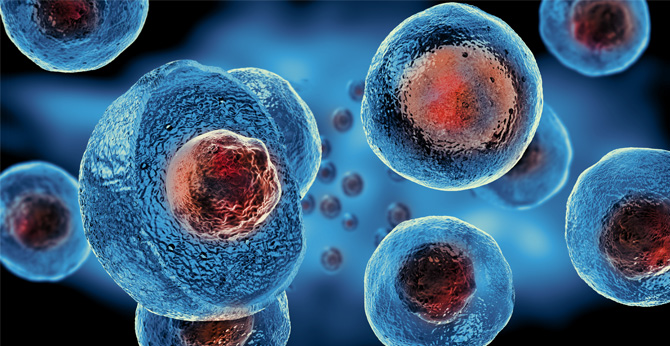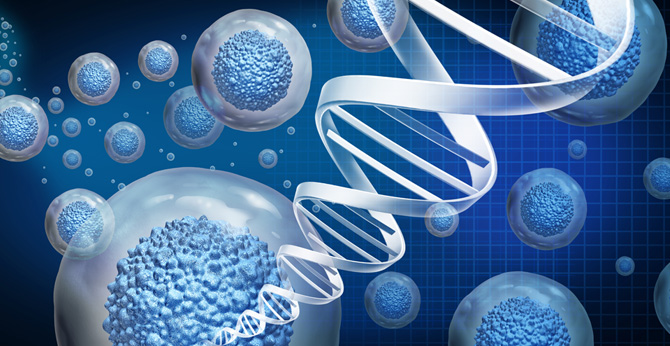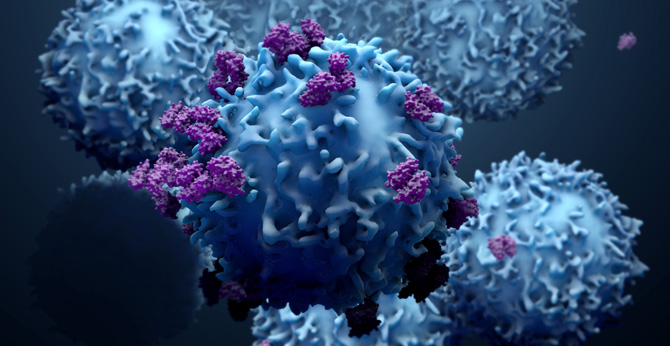All products and services are For Research Use Only and CANNOT be used in the treatment or diagnosis of disease.
Creative Biolabs has developed an extensive range of CD5 CAR products, including CAR vectors, CAR viral particles, CAR cells, and more. Kindly refer to the provided list for the products that suit your needs.
Human CD5 protein, also known as T-cell surface glycoprotein CD5, is a cell surface glycoprotein that is primarily expressed in T lymphocytes. It is important for maintaining immune tolerance and preventing autoimmunity. CD5 protein has been found to be associated with various diseases, including lymphomas, leukemias, and autoimmune diseases.
Targeting CD5 in immunotherapy offers several advantages. Firstly, CD5 is highly expressed in malignant B cells, making it an ideal target for antibody-based therapies. Secondly, CD5 is not expressed on normal B cells, which minimizes the potential off-target effects. Lastly, CD5 is known to be resistant to internalization, making it more accessible for antibody binding and subsequent immune responses.
 Fig.1 Surface expression of CD5 in T-ALL and T-lymphoma cell lines.1
Fig.1 Surface expression of CD5 in T-ALL and T-lymphoma cell lines.1
We offer a full range of CD5 protein products for CAR-T expression tests:
-Unconjugated CD5
-Biotinylated CD5
-Fluorescent-labeled CD5
-Custom cells with CD5 overexpression
CD5 CAR-T Cytokine Release Test
The released cytokines are quantitatively measured using different techniques, such as ELISA or multiplex assays, to detect a panel of cytokines. By analyzing the cytokine profile, we will assess the immunological response and potential adverse effects associated with CD5 CAR-T.
 Fig.2 Quantification of cytokines (TNF-α, IFN-γ, IL-2, IL-4, IL-6, and IL-10).1
Fig.2 Quantification of cytokines (TNF-α, IFN-γ, IL-2, IL-4, IL-6, and IL-10).1
CD5 CAR-T In Vitro Cytotoxicity Assay
We offer a comprehensive cytotoxicity test service using various methods, including the MTT assay, LDH release assay, and flow cytometry-based assays. This service can be customized to meet different experimental requirements. Moreover, the expertise of our team of scientists guarantees the precision and consistency of the findings.
 Fig.3 Cytotoxicity of CD5 CAR-T compared to CD19 CAR-T.2
Fig.3 Cytotoxicity of CD5 CAR-T compared to CD19 CAR-T.2
CD5 CAR-T Cell Proliferation Test
At Creative Biolabs, we are committed to delivering top-notch service for custom CAR-T cell or -NK cell proliferation assays, tailored to our customers' specific needs. we have various approaches to assess the activation and proliferation of these cells, such as MTT, MTS, cell counting kit-8 (CCK-8), and 5,6-carboxyfluorescein diacetate succinimidyl ester (CFSE).
CD5 CAR-T Cell Therapy Animal Models
These potential risks of CAR-T cell therapy could be linked to the use of CAR-T cell therapy. Ensuring safety is a top concern in developing new drugs and therapies. To evaluate toxicity, it is crucial to conduct animal testing to ensure the safety and well-being of subjects.
Creative Biolabs offers Efficacy Test and Toxicity Evaluation utilizing extensive expertise in preclinical in vivo research. Our approach includes the use of suitable models, comprehensive research methodologies, and high-caliber in vivo studies, ensuring exceptional quality.
 Fig.4 The control of progression of T-ALL by CD5 CAR T cells in xenograft mouse models.2
Fig.4 The control of progression of T-ALL by CD5 CAR T cells in xenograft mouse models.2
Do not hesitate to contact us for further information or to discuss how our CD5 CAR-related products and services can benefit you.
References
 Loading...
Loading...
| CAT | Product Name | Target Species | Antibody Clone | Antibody Host | Receptor Construction | Vector Type | Targeting Cell Type | CAR Vector Type | Inquiry & Datasheet |
| XS-1022-LX484 | Anti-CD5 (X10X316) h(CD28-CD3ζ) CAR, piggyBac vector system | Human | X10X316 | Mouse | scFv-CD28-CD3ζ | piggyBac transposon | T cell | ||
| XS-1022-LX485 | Anti-CD5 (X10X317) h(CD28-CD3ζ) CAR, piggyBac vector system | Human | X10X317 | Human | scFv-CD28-CD3ζ | piggyBac transposon | T cell | ||
| XS-1022-LX486 | Anti-CD5 (X10X318) h(CD28-CD3ζ) CAR, piggyBac vector system | Human | X10X318 | Human | scFv-CD28-CD3ζ | piggyBac transposon | T cell | ||
| XS-1022-LX487 | Anti-CD5 (X10X319) h(CD28-CD3ζ) CAR, piggyBac vector system | Human | X10X319 | Human | scFv-CD28-CD3ζ | piggyBac transposon | T cell | ||
| XS-1022-LX488 | Anti-CD5 (X10X320) h(CD28-CD3ζ) CAR, piggyBac vector system | Human | X10X320 | Human | scFv-CD28-CD3ζ | piggyBac transposon | T cell | ||
| XS-1022-LX489 | Anti-CD5 (X10X321) h(CD28-CD3ζ) CAR, piggyBac vector system | Human | X10X321 | Human | scFv-CD28-CD3ζ | piggyBac transposon | T cell | ||
| XS-1022-LX490 | Anti-CD5 (X10X322) h(CD28-CD3ζ) CAR, piggyBac vector system | Human | X10X322 | Human | scFv-CD28-CD3ζ | piggyBac transposon | T cell | ||
| XS-1022-LX491 | Anti-CD5 (X10X323) h(CD28-CD3ζ) CAR, piggyBac vector system | Human | X10X323 | Mouse | scFv-CD28-CD3ζ | piggyBac transposon | T cell | ||
| XS-1022-LX492 | Anti-CD5 (X10X324) h(CD28-CD3ζ) CAR, piggyBac vector system | Human | X10X324 | Mouse | scFv-CD28-CD3ζ | piggyBac transposon | T cell | ||
| XS-1022-LX493 | Anti-CD5 (X10X325) h(CD28-CD3ζ) CAR, piggyBac vector system | Human | X10X325 | Mouse | scFv-CD28-CD3ζ | piggyBac transposon | T cell | ||
| XS-1022-LX494 | Anti-CD5 (X10X326) h(CD28-CD3ζ) CAR, piggyBac vector system | Human | X10X326 | Mouse | scFv-CD28-CD3ζ | piggyBac transposon | T cell | ||
| XS-1022-LX495 | Anti-CD5 (X10X327) h(CD28-CD3ζ) CAR, piggyBac vector system | Human | X10X327 | Mouse | scFv-CD28-CD3ζ | piggyBac transposon | T cell | ||
| XS-1022-LX496 | Anti-CD5 (X10X328) h(CD28-CD3ζ) CAR, piggyBac vector system | Human | X10X328 | Mouse | scFv-CD28-CD3ζ | piggyBac transposon | T cell | ||
| XS-1022-LX497 | Anti-CD5 (X10X329) h(CD28-CD3ζ) CAR, piggyBac vector system | Human | X10X329 | Mouse | scFv-CD28-CD3ζ | piggyBac transposon | T cell | ||
| XS-1022-LX571 | Anti-CD5 (X10X403) h(CD28-CD3ζ) CAR, piggyBac vector system | Human | X10X403 | Humanized | scFv-CD28-CD3ζ | piggyBac transposon | T cell | ||
| XS-1022-LX572 | Anti-CD5 (X10X404) h(CD28-CD3ζ) CAR, piggyBac vector system | Human | X10X404 | Humanized | scFv-CD28-CD3ζ | piggyBac transposon | T cell | ||
| XS-1022-LX573 | Anti-CD5 (X10X405) h(CD28-CD3ζ) CAR, piggyBac vector system | Human | X10X405 | Humanized | scFv-CD28-CD3ζ | piggyBac transposon | T cell | ||
| XS-1022-LX574 | Anti-CD5 (X10X406) h(CD28-CD3ζ) CAR, piggyBac vector system | Human | X10X406 | Humanized | scFv-CD28-CD3ζ | piggyBac transposon | T cell | ||
| XS-1022-LX1147 | Anti-CD5 (X10X325) h(41BB-CD3ζ) CAR, piggyBac vector system | Human | X10X325 | Mouse | scFv-41BB-CD3ζ | piggyBac transposon | T cell | ||
| XS-1022-LX1148 | Anti-CD5 (X10X326) h(41BB-CD3ζ) CAR, piggyBac vector system | Human | X10X326 | Mouse | scFv-41BB-CD3ζ | piggyBac transposon | T cell | ||
| XS-0823-LX21 | Anti-hCD5 (5D7) ICD(CD28-OX40-CD3ζ) CAR-MA, pAd5f35 Vector | Human | 5D7 | Adenoviral vectors |
 NEWSLETTER
NEWSLETTER
The latest newsletter to introduce the latest breaking information, our site updates, field and other scientific news, important events, and insights from industry leaders
LEARN MORE NEWSLETTER NEW SOLUTION
NEW SOLUTION
CellRapeutics™ In Vivo Cell Engineering: One-stop in vivo T/B/NK cell and macrophage engineering services covering vectors construction to function verification.
LEARN MORE SOLUTION NOVEL TECHNOLOGY
NOVEL TECHNOLOGY
Silence™ CAR-T Cell: A novel platform to enhance CAR-T cell immunotherapy by combining RNAi technology to suppress genes that may impede CAR functionality.
LEARN MORE NOVEL TECHNOLOGY NEW SOLUTION
NEW SOLUTION
Canine CAR-T Therapy Development: From early target discovery, CAR design and construction, cell culture, and transfection, to in vitro and in vivo function validation.
LEARN MORE SOLUTION